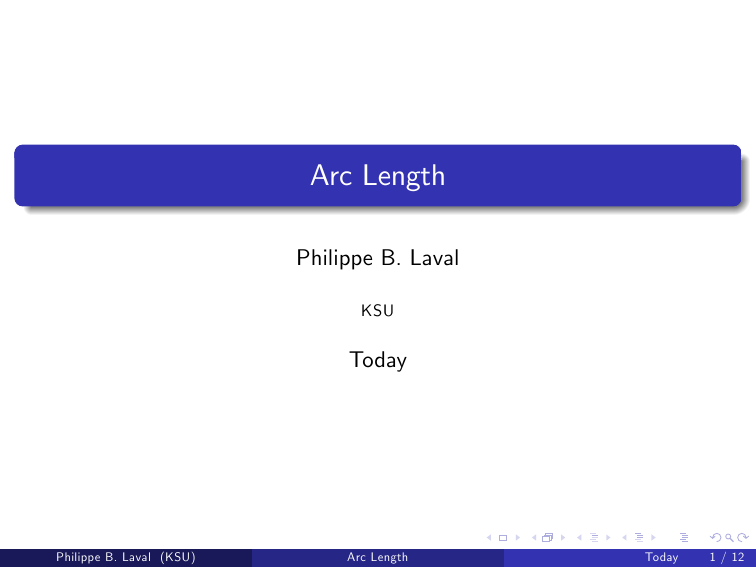Arc Length
advertisement

Arc Length Philippe B. Laval KSU Today Philippe B. Laval (KSU) Arc Length Today 1 / 12 Introduction In this section, we discuss the notion of curve in greater detail and introduce the very important notion of arc length and learn how to reparametrize a curve with respect to arc length. Philippe B. Laval (KSU) Arc Length Today 2 / 12 Parametrizations of a Curve We have described the curve C with position vector ! r (t) = hf (t) ; g (t) ; h (t)i for t 2 [a; b] as the set of points (x; y ; z) where 8 < x = f (t) y = g (t) : z = h (t) as t varies in the interval [a; b]. In fact, a curve is a little more than just a set of points. It is a succession of points traversed in a certain order. As t varies from a to b, the points obtained will trace the curve in a certain order. We say that a parametrized curve is an oriented curve. Often, the parameter represents time. The equations of the curve tell us where we are on the curve as a function of time. Other parameters can be used. For example, we could have equations which tell us where we are on the curve depending on how far we have traveled on the curve. Philippe B. Laval (KSU) Arc Length Today 3 / 12 Parametrizations of a Curve Given a curve C with position vector ! r (t), t 2 [a; b], if t can be expressed in terms of another parameter say u with the function t = f (u) then we can write ! r (t) = ! r (f (u)). We simply replaced t by f (u) since the two are equal. The result is a function of u. In other words, we have changed the parameter of the curve. In order to describe the same portion of the curve, we will also need to change the interval of values of the parameter. Such an operation is called a reparametrization of the curve C . The new parametrization describes the same curve, simply written in a di¤erent form. If f is an increasing function, then C will be traversed in the same direction. If f is a decreasing function then C will be traversed in opposite direction. Philippe B. Laval (KSU) Arc Length Today 4 / 12 Parametrizations of a Curve Example Consider the curve ! r (t) = hcos t; sin t; ti, t 2 [0; 2 ]. Reparametrize it with the parameter u given by t = f (u) = u. Is the curve traversed in the same order? Example Consider the curve ! r (t) = hcos t; sin t; ti, t 2 [0; 2 ]. Reparametrize it with the parameter v given by t = g (v ) = 2 u. Is the curve traversed in the same order? Example Consider the curve ! r (t) = hcos t; sin t; 0i, t 2 [0; 2 ]. Reparametrize it with the parameter u given by t = h (u) = 2 u. Is the curve traversed in the same order? Philippe B. Laval (KSU) Arc Length Today 5 / 12 Arc Length Of all the possible parameters for a curve, one parameter plays a very important role. It is arc length. We …rst give the de…nition of the length of the portion of a curve ! r (t) between t = a and t = b, valid for 2-D curves as well as 3-D curves. Though it is given here as a de…nition, the formula can actually be proven. De…nition (Arc Length) Let C be a smooth curve with position vector ! r (t) for t 2 [a; b]. The length of the portion of the curve between t = a and t = b is L= Z a b ! r 0 (t) dt It can also be proven that L as computed above does not depend on the parametrization used. Philippe B. Laval (KSU) Arc Length Today 6 / 12 Arc Length Example Compute the circumference of a circle of radius a, a > 0. Example Compute the length of the arc of the circular helix ! r (t) = hcos t; sin t; ti from the point (1; 0; 0) to the point (1; 0; 2 ). Philippe B. Laval (KSU) Arc Length Today 7 / 12 Arc Length We saw above that curves could be parametrized di¤erent ways. For motion along a curve, time is often the parameter of choice. However, to describe the geometric properties of a curve time is not the most appropriate parameter. The parameter of choice is arc length. We explain how this is done and why. De…nition (Arc length Function) Let C be a smooth curve with position vector ! r (t) for t 2 [a; b] and suppose C is traversed only once as t increases from a to b. We de…ne the arc length function from t = a, denoted s or s (t) to be Z t ! s (t) = r 0 (u) du a Philippe B. Laval (KSU) Arc Length Today 8 / 12 Arc Length Geometrically, s (t) is the length of the arc of C between ! r (a) and ! r (t). So, it is always a positive quantity which increases as t increases. From the de…nition of t and using the fundamental theorem of calculus, we have the following theorem. Theorem If s is the arc length function de…ned above then: ds 0 = ! r (t) dt We now show how a curve can be parametrized with respect to arc length. Goal: Given a smooth curve C with position vector ! r (t), t 2 I for some interval I , we want to reparametrize C with respect to arc length that is we need to …nd a relationship between t and s. To do this, we compute s (t) using the above formula for s (t). We illustrate this procedure with a few examples. Philippe B. Laval (KSU) Arc Length Today 9 / 12 Arc Length Example Reparametrize the helix ! r (t) = hcos t; sin t; ti with respect to arc length measured from the point (1; 0; 0). Example Reparametrize a circle of radius a centered at the origin given by ! r (t) = ha cos t; a sin ti, t 2 [0; 2 ] with respect to arc length. We invite the reader to check that in both examples above, we have !0 R (s) = 1. In fact, it can be proven that this is always true. We state this result as a theorem we will not prove. Philippe B. Laval (KSU) Arc Length Today 10 / 12 Arc Length Theorem Let C be a smooth curve with position vector ! r (s) where s is the arc length parameter. Then ! r 0 (s) = 1 Furthermore, if t is any parameter such that ! r 0 (t) = 1, then t must be the arc length parameter. Corollary Let C be a smooth curve with position vector ! r (s) where s is the arc length parameter. Then ! T (s) = ! r 0 (s) Philippe B. Laval (KSU) Arc Length Today 11 / 12 Exercises See the problems at the end of my notes on vector functions: arc length. Philippe B. Laval (KSU) Arc Length Today 12 / 12






